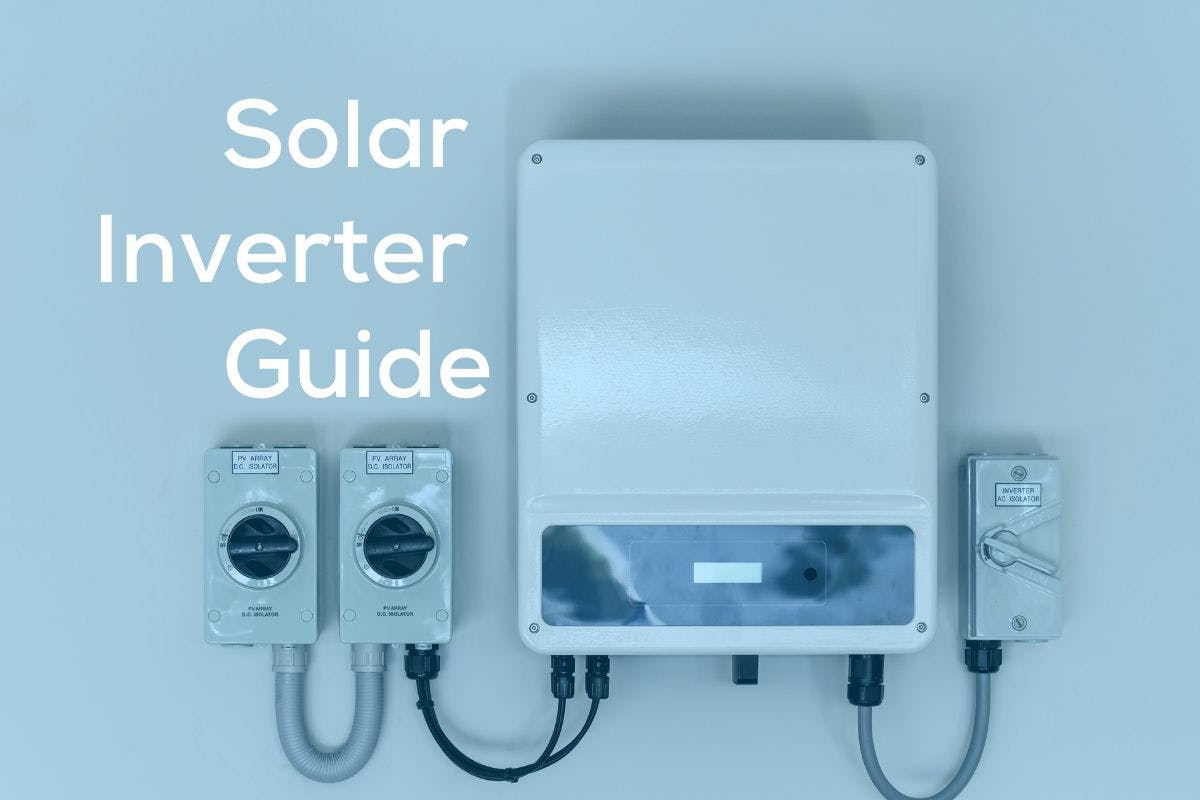Solar panels generate electricity. Your TV uses electricity. It’s not quite as simple as running a wire from one to the other. Without a solar inverter, your TV couldn’t use the solar energy from your home solar panels. An inverter must change the direct current electricity to alternating current electricity.
What else do you need to know about solar inverters? We could go back in scientific and American history to Thomas Edison and Nikola Tesla. More practically though, what do inverters do for watching football, cooking dinner, safety, and making clean, efficient energy possible?
See how much you can save by going solar with Palmetto
How a Solar Inverter Works
A solar power inverter’s primary purpose is to transform the direct current (DC) electricity generated by solar panels into usable alternating current (AC) electricity for your home. Because of this, you can also think of a solar inverter as a solar “converter.”
Once transformed to AC, solar electricity can power most household electronics and appliances. In the US, the power grid also uses AC, which means your post-inverter solar electricity can be sold to the grid and shared with others.
How a grid-tied solar inverter works
When a solar-powered system is connected to the grid, the inverter is the middleman between your home and the utility power lines. A grid-tied inverter allows your home to have uninterrupted power, no matter how much electricity your solar panels generate throughout the day.
When your solar power system is producing more electricity than your home is consuming, your solar inverter can transmit that excess power into the energy grid. Likewise, if your panels are producing some electricity, but not enough to run your entire home, you can utilize a mix of solar and grid power.
At night, when solar panels produce no electricity, your home may need to consume 100% of its power from the grid unless your system includes integrated energy storage. With solar batteries, your inverter can draw stored solar energy from your backup reserve at night or during an outage.
No matter if your home is running on grid power or the sun’s energy, your solar inverter can seamlessly switch between power sources to keep the lights on and systems running throughout your property.
Converting DC electricity into AC electricity
For those who want to know precisely how solar inverters work, here are the key principles to understand.
- Direct current electricity involves the flow of energy in a single direction. Conversely, alternating current electricity can change (or alternate) direction.
- When the sun’s rays hit photovoltaic (PV) panels, they trigger a one-directional movement of electrons into solar cells, generating DC electricity.
- The current then travels through the system’s wiring into a solar inverter. Here, the inverter rapidly switches the direction of the current back and forth, transforming it into AC.
The Benefits of a High-Quality Solar Inverter
While your solar inverter allows you to use the electricity your solar panels generate, it is also capable of many other essential tasks. A solar inverter can help maximize your energy production, monitor your system’s output, communicate with the utility grid, and detect faults that might otherwise cause damage or personal harm.
Maximizing energy production
Solar inverters can track your panel array’s voltage and maximize the ongoing efficiency of your renewable solar energy system. Today’s premium inverters for homes are very efficient, and can typically transform DC solar power into AC electricity at efficiency ratings up to 97%.
At the electrical level, high-quality grid-tied solar inverters output a pure sine wave, which is a measure of how smoothly the direction of the current can change. On the other hand, low-cost inverters generate a modified sine wave, which can be used to power non-delicate devices without a variable speed motor. Almost always, a pure sine wave inverter is recommended for home solar energy systems.
Monitoring system output
It's exciting to see your solar panels generate thousands of watt-hours on a sunny afternoon, so naturally, most people want to monitor their renewable energy system’s performance. Today, most solar energy system monitoring is done by the inverter.
With a modern solar inverter, you can typically view how much energy your solar panels are producing at any time through a mobile app or website. In the Palmetto App, users can see precise reports of solar watt-hour production alongside energy bill savings.
If things aren’t working as they should in your solar energy system, many inverters operate ongoing system performance checks to alert you of issues. You can also use your solar inverter’s performance tracking to periodically verify all components are working and generating the amount of electricity expected.
Communicating with the utility grid
If you have a full solar battery bank, or your household cannot use all the electricity being generated by your panels, your inverter can seamlessly feed this surplus power into the energy grid. If you live in an area with net metering, this can earn you credits that reduce your energy bill.
During a power outage, some solar inverters can separate your home from the grid, keeping the lights on at home while protecting line repair workers from the electricity your solar panels are producing.
Fault detection and automatic shut-off
When not properly maintained, aging electrical wiring and solar equipment can create potential electrical hazards, like ground faults or arcs. If such an event occurs, the solar inverter will quickly detect the issue and shut down, protecting the rest of the system and alerting you to the need for service before any additional damage occurs.
Inverters are a key feature of a safely operating solar panel system. Correct installation by a professional is a key first step to ensuring a long, safe, and productive life for your system.
Comparing Different Types of Solar Inverters
The type of solar inverter you get installed at your house will be determined by several factors.
- The shape and complexity of your roof
- The extent and frequency of shade on your property
- The brands your installer has partnered with
To guide your solar design decisions, the four key solar power inverter technologies to know are string inverters, microinverters, power optimizers, and hybrid inverters.
String inverters
Also called a central inverter, string inverters are most suitable for simple solar power system designs. The technology gets its name from arrays (or groups) of solar panels connected by 'strings' of wiring. From each string of solar panels, the DC electricity is then fed into one central inverter, where it is converted into AC power all at once.
Pros: String inverters have a few things going for them.
- Easy to install (typically at ground level)
- Most affordable
- Durable
Cons: Here are the main downsides of string inverters.
- One underperforming panel affects the rest of the string
- Not a good match for shaded roofs
- May not be a good match for complex or irregular system designs
Best For: A string inverter may be the best option as a low-cost solution for properties with basic roof layouts and little to no shade on-site.
Microinverters
Unlike string inverters (which are centrally located) microinverters are usually installed beneath or next to each solar panel in a system. So instead of power flowing into a single central inverter, microinverters transform DC electricity at each individual panel.
Pros: Here’s why you should consider a microinverter.
- Great for complicated system designs
- Better for roofs with shading
- Makes expanding your system easier
Cons: Here are the drawbacks.
- More expensive
- Harder to access for maintenance
Best for: Overall, microinverters are best for maximum energy output on complicated or shaded rooflines, where neighboring panels may generate varying amounts of electricity.
Power optimizers
Sort of a compromise between string and microinverters, power optimizers help maximize the performance of individual solar panels within a central inverter system. Like microinverters, power optimizers are installed at the panel-level and modify solar electricity before it is sent to a central location.
Pros: Power optimizers bring the benefits of microinverters.
- Maximize individual solar panel output
- Better for shading and complex designs
- Might be cheaper than microinverters
Cons: They have some of the same drawbacks as microinverters, too.
- More expensive than string inverters
- May make maintenance and part replacement more difficult
Best For: String inverters with power optimizers are a great alternative to microinverter-based systems where individual panel performance must be considered.
Hybrid inverters
Hybrid inverters are one of the newest additions to the fast-moving world of solar energy technology. A hybrid inverter combines a traditional solar inverter with a battery inverter component, with configurations optimized for every kind of solar energy system.
Pros: Hybrid inverters add capabilities to the basic inverter design.
- Can convert electricity from AC to DC and from DC to AC
- Integrates solar, battery, and home in one device
- Easier to add a battery at a later date
- Can allow more efficient direct current charging of batteries or electric vehicles
Cons: Hybrid inverters have one main downside.
- Higher initial cost (though can be a good long-term investment)
Best For: Hybrid inverters are the best option for those considering solar, battery storage, and EV charging as parts of a whole, comprehensive home energy system.
See how much you can save by going solar with Palmetto
Measuring Solar Inverter Efficiency
During a solar inverter's DC to AC electricity conversion, some energy is lost in the form of heat. The less energy lost through heat, the greater the inverter’s efficiency.
Solar conversion efficiencies vary by brand, but most quality home inverters have a maximum efficiency of 97% to 99%, so energy loss is relatively minor. While operating in real-world conditions, however, shading, weather, and your other solar equipment will have an impact on your system’s overall energy production efficiency.
Solar Inverter Sizing
Inverter manufacturers always specify the input energy their products can process and their maximum power output. For instance, a string inverter may be able to handle a maximum input energy of 4,000 watts from solar panels, and output 3,000 watts.
In the real world, however, you will rarely achieve your inverter's nameplate power rating, which is measured at Standard Test Conditions, or STC. Instead, your typical daily activities may end up 10% to 20% below the nameplate power rating. To keep costs down, inverters are often selected with an input power rating lower than your solar panel array’s maximum output.
Inverter clipping explained
Solar installers will make sure the photovoltaic inverter size matches the capacity of the solar array for optimum power conversion. You may be surprised to learn it’s usually not an exact match. For instance, just because you have 5 kilowatts of solar panels doesn’t mean you will pair them with a 5-kilowatt inverter.
Typically it’s more cost effective to pick an inverter designed to handle slightly less electricity than the maximum amount of power the solar panels can generate. When the panels are generating this extra electricity capacity the inverter can’t handle, it’s called clipping, and the extra electricity is lost to the system.
So while you may throw away this extra electricity, inverter clipping typically occurs only at the height of the afternoon during the most productive days of the year. Therefore, most installers favor solar inverters designed to handle the average amount of daily power to keep total installation costs low, even if it means losing a little bit of solar electricity generation in peak conditions.
Local Solar Inverter Regulations
In general, local regulations for solar inverters are rarely something you need to worry about as a homeowner. Reputable solar installers will be familiar with the specific rules governing solar energy installations in your area.
Your system size is typically limited by your inverter's size, rather than the number of panels you install. In most cases, your solar inverter’s maximum capacity may be rated to match or slightly exceed your home’s approximate annual electricity demand.
The Environmental Impact of Solar Inverters
Overall, solar inverters do more environmental good than harm. While there’s an environmental cost to manufacturing anything, inverters’ role in unlocking clean, renewable solar power is more than worth it.
Thankfully, the majority of a solar inverter can be recycled, with many materials retaining their value for scrap at the end of a system’s lifetime. Solar inverters should always be handled by a professional, since some may include hazardous materials.
How Much Does a Solar Inverter Cost?
Narrowing down the price of a solar inverter to a single number can be tricky because every system design is different. Your inverter’s size will be determined by your energy consumption and your system design.
Additionally, installers typically buy in bulk and have direct relationships with suppliers, so their costs may be different than what you’d pay online. When looking at your solar system as a whole, inverters will typically make up around 10% of your total project costs.
String inverter prices usually range between $1,000-$2,000 or slightly more. Power optimizers can boost your total costs $50-$200 per panel. You can expect to pay $200-$400 per panel for microinverters.
How Long Does a Solar Inverter Last?
Most residential string inverters have an expected lifespan and performance warranty of 10-15 years, but can sometimes last up to two decades. However, most string inverters are replaced within the operating lifetime of the solar panels to which they are connected.
Microinverters and power optimizers are newer technologies, so there is less data on their expected lifespans. That said, most manufacturers are confident their products will outlast the 20- and 25-year warranties included with the equipment. Factor possible replacement costs outside of warranty periods into your system design decision-making.
What Solar Inverter Maintenance Is Required?
Solar inverters rarely require maintenance. When something goes wrong, inverters are usually replaced, not repaired.
If your system is working less efficiently than usual or not generating electricity at all, it may be time to contact your solar company to see what maintenance is required. Trying to troubleshoot inverter problems on your own can be dangerous and could invalidate warranties.
What Solar Inverter Is Right for My Home?
If you're looking to invest in a home solar power system and trying to decide what inverter option to utilize, an easy way to get started is with our free solar savings calculator.
In a few easy steps, you will receive an estimate of how much solar can save you. You'll also get connected with a solar expert who can review the different solar options that make sense for your home and help you select the one that's right for your family’s needs.
See what solar can do for you:
Frequently Asked Questions
What does a solar inverter do?
A solar inverter turns DC electricity, coming from the panels, into AC electricity, which is the standard electricity used by grids, homes, and most devices in the US.
Can solar panels work without an inverter?
Scientifically speaking, yes. Practically speaking, to turn the electricity panels generate into electricity you can use, no.
Are string inverters or microinverters better for home solar?
Microinverters are usually better for home solar systems. Microinverters optimize your system’s efficiency as they work better when some panels are in shade at varying times. More positives include having a longer lifespan than string inverters, being able to add panels easier, being easier to do maintenance on, and getting better energy efficiency will, in the long run, more than make up for the higher initial cost compared to string inverters. A string inverter can work as a lower-cost choice for properties with basic roof layouts and little to no shade.
 Andrew GiermakWriter and Editor
Andrew GiermakWriter and EditorAndrew joined Palmetto in Charlotte in August 2024. He’s been a writer in journalism, then in business, going back to almost the 20th century. He’s lived in Indiana, Virginia, Pennsylvania, Virginia again, and now North Carolina for the last 12 years. He likes golf. Is he good at it? Not so much.

